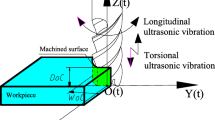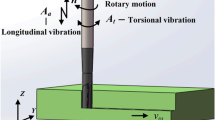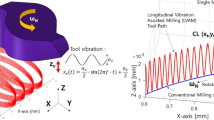Abstract
For difficult-to-cut materials such as titanium alloy, a machining method of longitudinal-torsion ultrasonic-assisted milling (LTUM) was put forward to realize the anti-fatigue manufacturing, and cutting force, cutting temperature and residual stress (RS) were analyzed by 3D finite element simulation (FES). Firstly, based on thermal mechanical coupling, a 3D FES model of ultrasonic milling was established, the simulation of the cutting force, cutting temperature and RS were realized. Then, based on the 3D FES milling model, the milling process was equivalent to the oblique cutting model, it effectively improved the computation efficiency and realized longitudinal-torsional ultrasonic compound in milling process. Base on 3D equivalent model, compared with traditional milling (TM) and LTUM from the cutting force, cutting temperature and machined-induced RS. It is concluded that the LTUM effectively reduces the cutting force and cutting temperature, increases surface compressive stress and compressive stress layer depth. Furthermore, experiments were carried out to verify the equivalent model of LTUM, it shows that the simulated results are in agreement with experimental results, and predicts cutting force, cutting temperature and RS with high precision.


































Similar content being viewed by others
References
Su H, Liu P, Fu Y, Xu J (2012) Tool life and surface integrity in high-speed milling of titanium alloy TA15 with PCD/PCBN tools. Chin J Aeronaut 25:784–790. https://doi.org/10.1016/S1000-9361(11)60445-7
Sawant MS, Jain NK, Palani IA (2018) Influence of dimple and spot-texturing of HSS cutting tool on machining of Ti-6Al-4V. J Mater Process Technol 261:1–11. https://doi.org/10.1016/j.jmatprotec.2018.05.032
Aslantas K, Ekici E, Cicek A (2018) Optimization of process parameters for micro milling of Ti-6Al-4V alloy using Taguchi-based gray relational analysis. Meas: J Int Meas Conf 128:419–427. https://doi.org/10.1016/j.measurement.2018.06.066
Cellier A, Chalon F, Grimal-Perrigouas V, Bonhoure D, Leroy R (2014) Effects of cutting angles in Ti-6al-4v milling process on surface integrity: influence of roughness and residual stresses on fatigue limit. Mach Sci Technol 18:565–584. https://doi.org/10.1080/10910344.2014.955369
Nespor D, Denkena B, Grove T, Boc V (2015) Differences and similarities between the induced residual stresses after ball end milling and orthogonal cutting of Ti-6Al-4V. J Mater Process Technol 226:15–24. https://doi.org/10.1016/j.jmatprotec.2015.06.033
Hou J, Zhou W, Duan H, Yang G, Xu H, Zhao N (2014) Influence of cutting speed on cutting force, flank temperature, and tool wear in end milling of Ti-6Al-4V alloy. Int J Adv Manuf Technol 70:1835–1845. https://doi.org/10.1007/s00170-013-5433-8
Wang J, Zhang J, Feng P, Guo P (2018) Experimental and theoretical investigation on critical cutting force in rotary ultrasonic drilling of brittle materials and composites. Int J Mech Sci 135:555–564. https://doi.org/10.1016/j.ijmecsci.2017.11.042
Niu Y, Jiao F, Zhao B, Gao G (2019) Investigation of cutting force in longitudinal- torsional ultrasonic-assisted milling of Ti-6Al-4V. Materials,12. https://doi.org/10.3390/ma12121955
Zhu Y, Wang K, Li L, Huang Y (2009) Evaluation of an ultrasound-aided deep rolling process for anti-fatigue applications. J Mater Eng Perform 18:1036–1040. https://doi.org/10.1007/s11665-008-9341-2
Ma C, Wang Z (2018) Experimental and numerical investigation of the breakage of a cutting tool with ultrasonic vibration. Precis Eng 51:393–402. https://doi.org/10.1016/j.precisioneng.2017.09.011
Niu Y, Jiao F, Zhao B, Wang D (2017) Multiobjective optimization of processing parameters in longitudinal-torsion ultrasonic assisted milling of Ti-6Al-4V. Int J Adv Manuf Technol 93:4345–4356. https://doi.org/10.1007/s00170-017-0871-3
Xiang D, Wu B, Yao Y, Liu Z, Feng H (2019) Ultrasonic longitudinal-torsional vibration-assisted cutting of Nomex® honeycomb-core composites. Int J Adv Manuf Technol 100:1521–1530. https://doi.org/10.1007/s00170-018-2810-3
Wu C, Chen S, Xiao C, Cheng K, Ding H. (2019) Longitudinaltorsional ultrasonic vibration-assisted side milling process. Proceedings of the Institution of Mechanical Engineers, Part C: Journal of Mechanical Engineering Science,233:3356-3363. https://doi.org/10.1177/0954406218819023
Mohammadpour M, Razfar MR, Jalili SR (2010) Numerical investigating the effect of machining parameters on residual stresses in orthogonal cutting. Simul Model Pract Theory 18:378–389. https://doi.org/10.1016/j.simpat.2009.12.004
Song S, Zuo D (2014) Modelling and simulation of whirling process based on equivalent cutting volume. Simul Model Pract Theory 42:98–106. https://doi.org/10.1016/j.simpat.2013.12.011
Salonitis K, Kolios A (2015) Experimental and numerical study of grind-hardening-induced residual stresses on AISI 1045 steel. Int J Adv Manuf Technol 79:1443–1452. https://doi.org/10.1007/s00170-015-6912-x
Yaich M, Ayed Y, Bouaziz Z, Germain G (2017) Numerical analysis of constitutive coefficients effects on FE simulation of the 2D orthogonal cutting process: application to the Ti6Al4V. Int J Adv Manuf Technol 93:283–303. https://doi.org/10.1007/s00170-016-8934-4
Binder M, Klocke F, Doebbeler B (2017) An advanced numerical approach on tool wear simulation for tool and process design in metal cutting. Simul Model Pract Theory 70:65–82. https://doi.org/10.1016/j.simpat.2016.09.001
Mamedov A, Lazoglu I (2016) Thermal analysis of micro milling titanium alloy Ti-6Al-4V. J Mater Process Technol 229:659–667. https://doi.org/10.1016/j.jmatprotec.2015.10.019
Ducobu F, Riviere-Lorphevre E, Filippi E (2017) Finite element modelling of 3D orthogonal cutting experimental tests with the coupled Eulerian-Lagrangian (CEL) formulation. Finite Elem Anal Des 134:27–40. https://doi.org/10.1016/j.finel.2017.05.010
Wu Q, Xie D, Si Y, Zhang Y, Li L, Zhao Y (2018) Simulation analysis and experimental study of milling surface residual stress of Ti-10V-2Fe-3Al. J Manuf Process 32:530–537. https://doi.org/10.1016/j.jmapro.2018.03.015
Jiang X, Li B, Yang J, Zuo X, Li K (2013) An approach for analyzing and controlling residual stress generation during high-speed circular milling. Int J Adv Manuf Technol 66:1439–1448. https://doi.org/10.1007/s00170-012-4421-8
Lotfi M, Amini S, Aghaei M (2018) 3D FEM simulation of tool wear in ultrasonic assisted rotary turning. Ultrasonics 88:106–114. https://doi.org/10.1016/j.ultras.2018.03.013
Patil S, Joshi S, Tewari A, Joshi SS (2014) Modelling and simulation of effect of ultrasonic vibrations on machining of Ti6Al4V. Ultrasonics 54:694–705. https://doi.org/10.1016/j.ultras.2013.09.010
Elhami S, Razfar MR, Farahnakian M (2015) Analytical, numerical and experimental study of cutting force during thermally enhanced ultrasonic assisted milling of hardened AISI 4140. Int J Mech Sci 103:158–171. https://doi.org/10.1016/j.ijmecsci.2015.09.007
Paktinat H, Amini S. (2018) Experiments and finite element simulation of ultrasonic assisted drilling. Journal of Manufacturing Science and Engineering, Transactions of the ASME,140. doi: https://doi.org/10.1115/1.4040321
Sofuolu MA, Cakir FH, Gurgen S, Orak S, Kuhan MC (2018) Numerical investigation of hot ultrasonic assisted turning of aviation alloys. J Bra Soc Mech Sci Eng 40. https://doi.org/10.1007/s40430-018-1037-4
Çakır FH, Sofuoğlu MA, Gürgen S (2018) Machining of Hastelloy-X based on finite element modelling. Advanced Engineering Forum 30:1–7. https://doi.org/10.4028/www.scientific.net/AEF.30.1
Patil S, Joshi S, Tewari A, Joshi SS (2014) Modelling and simulation of effect of ultrasonic vibrations on machining of Ti6Al4V. Ultrasonics 54:694–705. https://doi.org/10.1016/j.ultras.2013.09.010
Atlati S, Haddag B, Nouari M, Zenasni M (2014) Thermomechanical modelling of the tool-workmaterial interface in machining and its implementation using the ABAQUS VUINTER subroutine. Int J Mech Sci 87:102–117. https://doi.org/10.1016/j.ijmecsci.2014.05.034
Funding
The paper is sponsored by National Natural Science Foundation of China (No. 51675164) and (No. U1604255), and China postdoctoral science foundation (No. 2019M662493).
Author information
Authors and Affiliations
Corresponding author
Additional information
Publisher’s note
Springer Nature remains neutral with regard to jurisdictional claims in published maps and institutional affiliations.
Rights and permissions
About this article
Cite this article
Ying, N., Feng, J. & Bo, Z. A novel 3D finite element simulation method for longitudinal-torsional ultrasonic-assisted milling. Int J Adv Manuf Technol 106, 385–400 (2020). https://doi.org/10.1007/s00170-019-04636-8
Received:
Accepted:
Published:
Issue Date:
DOI: https://doi.org/10.1007/s00170-019-04636-8




